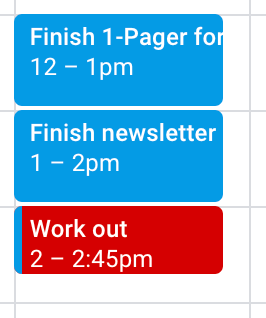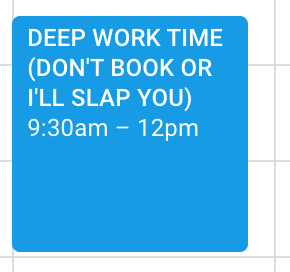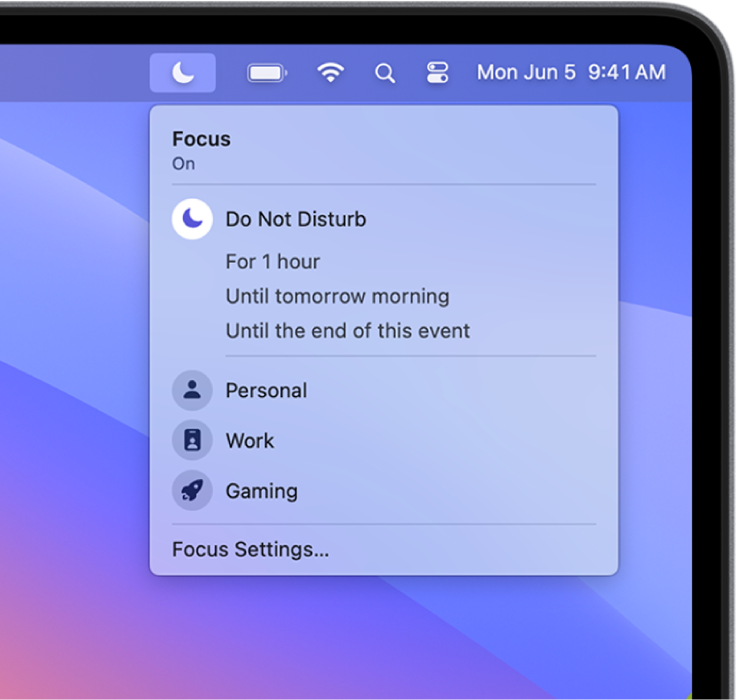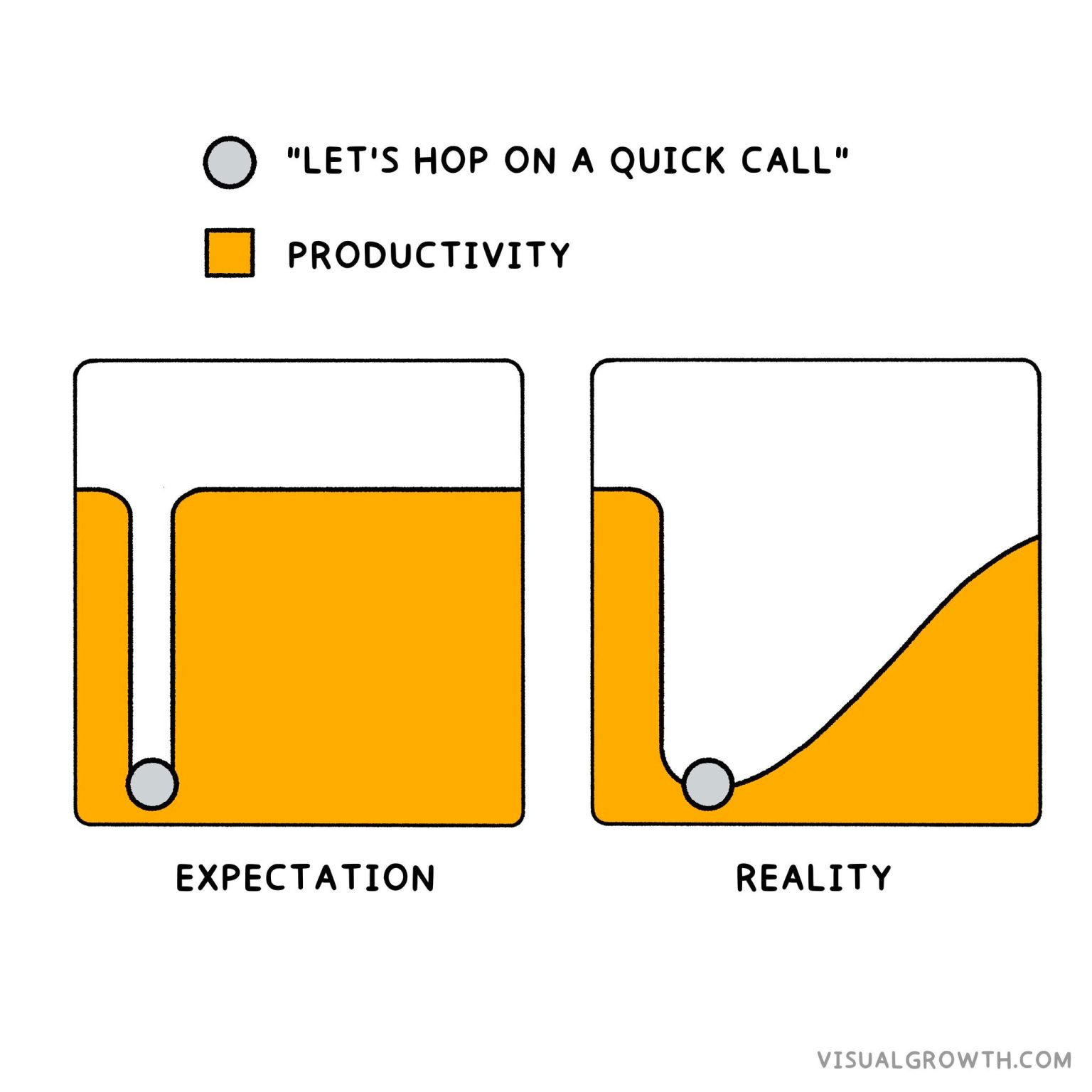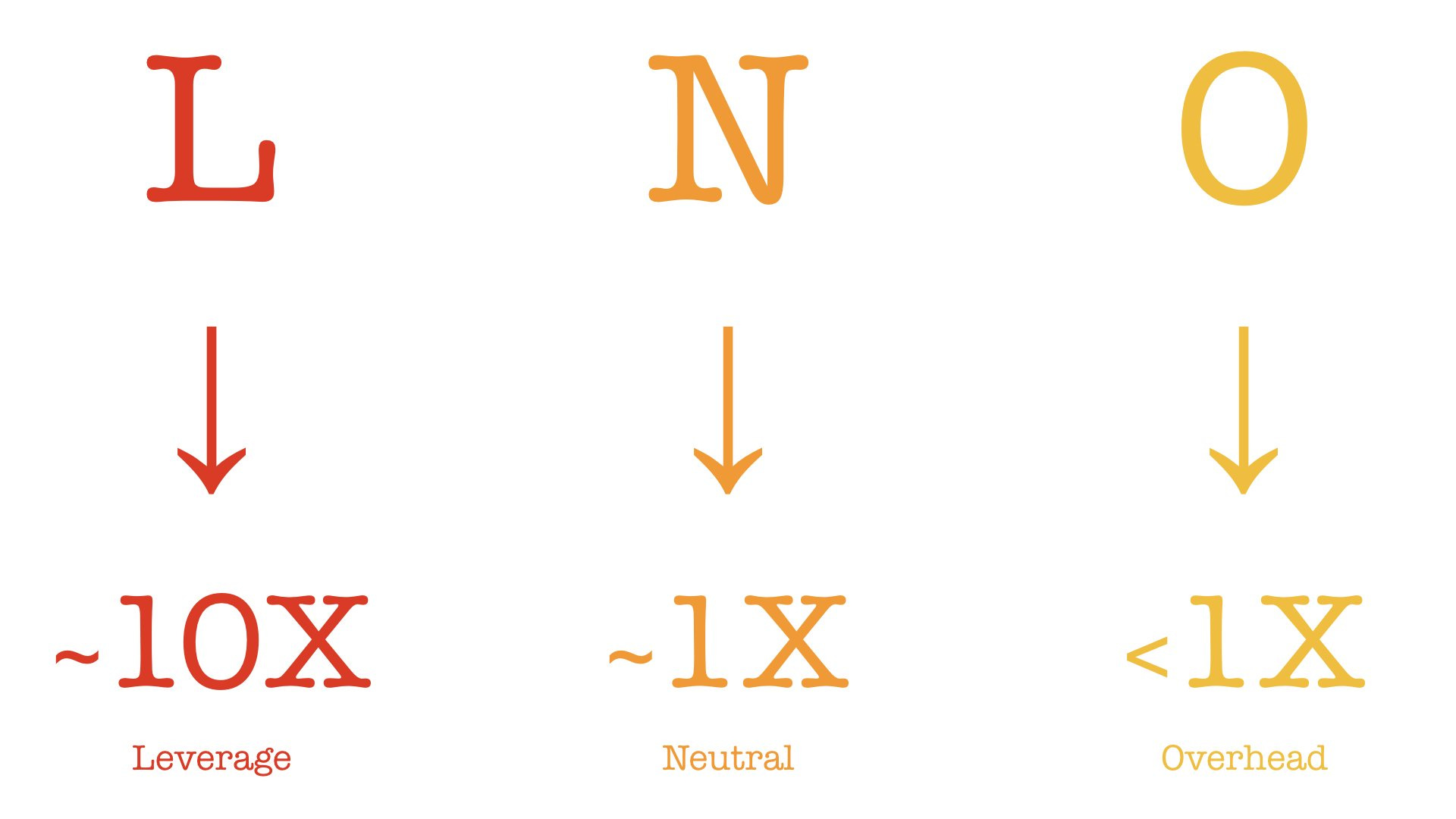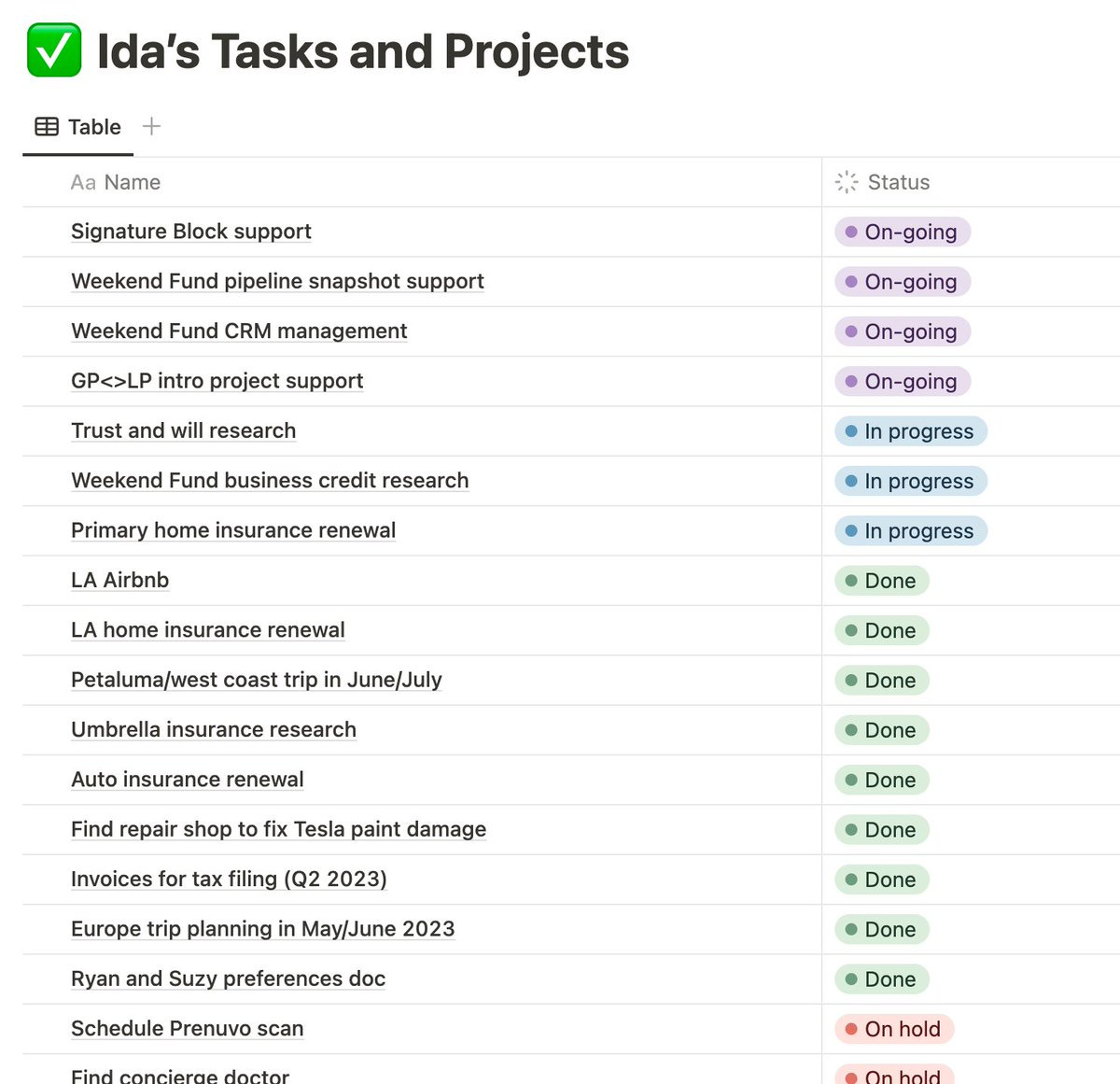Time management techniques that actually work
👋 Hey, Lenny here! Welcome to this month’s ✨ free edition ✨ of Lenny’s Newsletter. Each week, I tackle reader questions about building product, driving growth, and accelerating your career. If you’re not a subscriber, here’s what you missed this month: Subscribe to get access to these posts, and every post. For more: Best of Lenny’s Newsletter | Hire your next product leader | Podcast | Lennybot | Swag.
There are a lot of big ideas out there for how to use your time most effectively, but sometimes you just need a few really good tricks. Over the years, I’ve read dozens of productivity books and tried a bunch of stuff. Most of the ideas work for a few weeks and then fade. But below are 10 techniques that have stuck with me. I use them daily, and they consistently help me get more stuff done. Pick a few to try and see how it goes for you. 1. Use your calendar for to-dosInstead of adding to-dos to an app, try slotting some into your calendar. You don’t need any fancy tools for this—literally just make your to-do into an event and put it on your calendar: If something comes up and you aren’t able to do the task at that time, move the event to a new slot. This works because your calendar is basically your personal roadmap. And we all know what happens when something isn’t on your roadmap. This tactic comes from both Nir Eyal in his book Indistractable and from Jake Knapp and John Zeratsky’s book Make Time. It also came up a bunch in this X thread asking for people’s favorite productivity tips. Go even further: Sunday evening, plan out your week ahead by slotting your most important to-dos into your calendar. 2. If it takes less than two minutes, just do itNext time you’re about to add a task to your to-do list and you think it would take less than two minutes to do, just do it right then instead. This tip comes from David Allen’s book Getting Things Done, which I read over 15 years ago. This trick is so good that it’s stuck with me for that long.
3. Keep a “waiting for” listWhenever you ask someone to do something for you, add them to your “waiting for” list. I keep this alongside my to-do list: This tactic also comes from the Getting Things Done framework, and it changed my life. One of the most important habits of highly effective PMs is creating an aura of “I got this,” and the best way to build that aura is to never drop the ball. This tactic allows you to keep track of every open thread, versus relying on your memory, and makes it easy to remember to check in when someone else is dropping the ball. Once your brain knows that the information is written down somewhere, it can relax and create space for much more valuable thinking. If you’re using a to-do app, you can alternatively note who you’re waiting on (aka who’s blocking progress on that task) within the task description: 4. Each morning, write down just 1-3 things you have to accomplish that dayBefore you open up your to-do list—and definitely before you dive into your work—pick one to three things that, if you got done today (and if you did nothing else), would make it a great day. Write these items down. Don’t write more than three. Even better, create time in your calendar to work on these items each morning. Mornings are great for trying to knock these out because your mind is at its most productive, and after you get the most important things done, the rest of your day is going to feel like gravy. Keeping this list short makes it much more likely that you’ll accomplish any of them. And yes, ideally, you get more than three things done in a day, but often we end up doing a lot of easy things instead of the one to three we should really do. This idea is inspired by Matt Mochary’s Top Goal approach, and picking one “highlight” for your day from the book Make Time. If you want to take this further, do the hardest thing on your list first, aka “eat the frog,” which is an idea the internet tells me is attributed to Mark Twain:
5. Set up, and fiercely protect, regular deep work timeOne of the most important professional development books I’ve ever read is Deep Work by Cal Newport. The core idea is that any work of real value comes from people doing “deep work”—focused, uninterrupted, and cognitively demanding work that stretches their brain. Unfortunately, most of our time is spent on “shallow work”—not cognitively demanding, logistical-style tasks, often performed while distracted. And that’s totally OK, as long as you get enough deep work time in. It takes time to get into a deep work state (30 to 60 minutes) and, more importantly, you need to avoid distractions to stay in this mode. What worked really well for me while I was working full-time was creating two to three recurring blocks each week that were dedicated to deep work time. Those were basically the only time I got “real” work done, and I treasured them. The key is to not let anyone ever schedule over this time. Here’s my approach (which worked really well, FWIW): Go even further:
6. Make a rule: No meetings before [as late as possible]This is going to sound absurd to most people, but I currently have a rule of no meetings before 3 p.m. It used to be 2 p.m., but I made it later. And it made my life so much better. I do this because I’d rather use that time (when my brain is freshest) for generative, creative, deep work as much as I can. I know this isn’t something most people will be able to do. However, I bet you could (for at least some days of the week) have a rule of no meetings before, say, 10 a.m. Or maybe even 11 a.m.? And I bet your team would love it. Jeff Bezos (one of the most successful businesspeople in history) makes time each morning to “putter around.” And many people mentioned this idea when I asked them for their favorite productivity tactic. 7. Keep Do Not Disturb mode onImagine a product that could turn off all notifications, calls, SMSs, pushes, buzzes, etc., across all of your devices in a couple of clicks. This product exists, it’s free, and it’s built into your operating system. The smartest people I know leave it on all the time. Here’s how you can turn it on on your Mac and on your PC. Go even further: When I really need to get deep, I physically remove all of my distractions. I put my phone in another room and kill anything I’d be tempted to check in on even without getting a notification (e.g. Slack, Messages, X). 8. Keep work asyncOne of the biggest unlocks in my productivity has been learning how to pivot a meeting request into an email conversation. The majority of the time this becomes a five-minute task versus a 30- to 60-minute meeting. Here’s a reply template you can steal/tweak for when someone sends you a meeting invite:
It’s so easy to schedule a meeting. No sweat off that person’s back to send that invite. It’s also kinda fun to hang out and avoid your work for a bit, and sitting in a meeting feels like you’re working. The worst part is that it isn’t just the meeting time itself you’re wasting. It’s also the time before the meeting, when you aren’t able to go deep on anything (it’s almost meeting time!), and the time after the meeting, when you have to rebuild context on whatever you were doing. I’ll add, though, that sometimes meetings can indeed be great and a much better use of time than going back and forth over email. It’s just that this is usually not the case, so meetings shouldn’t be the default. 9. Get a virtual assistant to take on low-impact workShreyas Doshi has a great productivity framework, called the LNO framework, which helps you identify which tasks you should spend time on versus which to avoid and/or delegate away. An unlock for me has been finding an executive assistant to take on as many of these N and O tasks as possible. I know this sounds extravagant, but it’s really not. You just sign up for a site like Double (there’s also Athena and Fancy Hands and others), and you get matched with someone awesome. Everyone starts off thinking there’s very little an EA can do for them, and then months later they’re doing 20 to 30 hours of work a week for you. There’s up-front effort in getting the virtual assistant set up, but it quickly becomes very high ROI. Here’s Ryan Hoover sharing how he uses an EA, and Sam Corcos, the co-founder and CEO of Levels, wrote this in-depth guide to how to use EAs across your company. 10. Say no more often, even when it’s hardI can’t write a productivity guide for product managers without also encouraging you to say no more often. It’s a rule. Most of our burnout and overwhelm comes not from a lack of productivity tools and tricks, but from taking on too much work. The more you can do up front to make your workload less full, the better everything gets downstream. To help you say no more often, I pulled some tactical advice from previous pieces I’ve written:
Here are a few templates for saying no that you can adapt to your situation. — Is there anything that’s worked super-well for you that I didn’t mention, or that you totally agree with? Share in the comments 🙏 📚 Additional frameworks and tactics to explore
Have a fulfilling and productive week 🙏 👀 Hiring? Or looking for a new job?I’ve got a white-glove recruiting service for senior product roles, working with a few select companies at a time. If you’re hiring, apply below. If you’re exploring new opportunities yourself, use the same button above to sign up. We’ll send over personalized opportunities from hand-selected companies if we think there’s a fit. If you’re finding this newsletter valuable, share it with a friend, and consider subscribing if you haven’t already. There are group discounts, gift options, and referral bonuses available. Sincerely, Lenny 👋 You're currently a free subscriber to Lenny's Newsletter. For the full experience, upgrade your subscription. |
Older messages
Improve strategy, influence, and decision-making by understanding your brain | Evan LaPointe (founder of CORE Scie…
Sunday, August 11, 2024
Learn how brain science can improve your collaboration, decision-making, and innovation with Evan LaPointe. ͏ ͏ ͏ ͏ ͏ ͏ ͏ ͏ ͏ ͏ ͏ ͏ ͏ ͏ ͏ ͏ ͏ ͏ ͏ ͏ ͏ ͏ ͏ ͏ ͏ ͏ ͏ ͏ ͏ ͏ ͏ ͏ ͏ ͏ ͏ ͏ ͏ ͏ ͏ ͏ ͏ ͏ ͏ ͏ ͏ ͏ ͏
How embracing your emotions will accelerate your career | Joe Hudson (executive coach, Art of Accomplishment)
Thursday, August 8, 2024
Joe Hudson's coaching has transformed leaders at Apple, OpenAI, and Google. Learn how to change your critical inner voice and embrace authentic growth. ͏ ͏ ͏ ͏ ͏ ͏ ͏ ͏ ͏ ͏ ͏ ͏ ͏ ͏ ͏ ͏ ͏ ͏ ͏ ͏ ͏ ͏ ͏
On asking for help (even when you really don’t want to)
Tuesday, August 6, 2024
Step-by-step tactics for facing your fears and making the ask—including templates and example scripts ͏ ͏ ͏ ͏ ͏ ͏ ͏ ͏ ͏ ͏ ͏ ͏ ͏ ͏ ͏ ͏ ͏ ͏ ͏ ͏ ͏ ͏ ͏ ͏ ͏ ͏ ͏ ͏ ͏ ͏ ͏ ͏ ͏ ͏ ͏ ͏ ͏ ͏ ͏ ͏ ͏ ͏ ͏ ͏ ͏ ͏ ͏ ͏ ͏ ͏
Lessons from scaling Uber and Opendoor | Brian Tolkin (Head of Product at Opendoor, ex-Uber)
Sunday, August 4, 2024
Discover how Brian Tolkin, Opendoor's Head of Product, integrates product and operations, makes decisions, and stays calm under pressure. ͏ ͏ ͏ ͏ ͏ ͏ ͏ ͏ ͏ ͏ ͏ ͏ ͏ ͏ ͏ ͏ ͏ ͏ ͏ ͏ ͏ ͏ ͏ ͏ ͏ ͏ ͏ ͏ ͏ ͏
How should you monetize your AI features?
Tuesday, July 30, 2024
What we can learn from the monetization strategies of leading tech companies, including GitHub, Zapier, Adobe, Loom, and Microsoft ͏ ͏ ͏ ͏ ͏ ͏ ͏ ͏ ͏ ͏ ͏ ͏ ͏ ͏ ͏ ͏ ͏ ͏ ͏ ͏ ͏ ͏ ͏ ͏ ͏ ͏ ͏ ͏ ͏ ͏ ͏ ͏ ͏ ͏ ͏
You Might Also Like
🚀 Ready to scale? Apply now for the TinySeed SaaS Accelerator
Friday, February 14, 2025
What could $120K+ in funding do for your business?
📂 How to find a technical cofounder
Friday, February 14, 2025
If you're a marketer looking to become a founder, this newsletter is for you. Starting a startup alone is hard. Very hard. Even as someone who learned to code, I still believe that the
AI Impact Curves
Friday, February 14, 2025
Tomasz Tunguz Venture Capitalist If you were forwarded this newsletter, and you'd like to receive it in the future, subscribe here. AI Impact Curves What is the impact of AI across different
15 Silicon Valley Startups Raised $302 Million - Week of February 10, 2025
Friday, February 14, 2025
💕 AI's Power Couple 💰 How Stablecoins Could Drive the Dollar 🚚 USPS Halts China Inbound Packages for 12 Hours 💲 No One Knows How to Price AI Tools 💰 Blackrock & G42 on Financing AI
The Rewrite and Hybrid Favoritism 🤫
Friday, February 14, 2025
Dogs, Yay. Humans, Nay͏ ͏ ͏ ͏ ͏ ͏ ͏ ͏ ͏ ͏ ͏ ͏ ͏ ͏ ͏ ͏ ͏ ͏ ͏ ͏ ͏ ͏ ͏ ͏ ͏ ͏ ͏ ͏ ͏ ͏ ͏ ͏ ͏ ͏ ͏ ͏ ͏ ͏ ͏ ͏ ͏ ͏ ͏ ͏ ͏ ͏ ͏ ͏ ͏ ͏ ͏ ͏ ͏ ͏ ͏ ͏ ͏ ͏ ͏ ͏
🦄 AI product creation marketplace
Friday, February 14, 2025
Arcade is an AI-powered platform and marketplace that lets you design and create custom products, like jewelry.
Crazy week
Friday, February 14, 2025
Crazy week. ͏ ͏ ͏ ͏ ͏ ͏ ͏ ͏ ͏ ͏ ͏ ͏ ͏ ͏ ͏ ͏ ͏ ͏ ͏ ͏ ͏ ͏ ͏ ͏ ͏ ͏ ͏ ͏ ͏ ͏ ͏ ͏ ͏ ͏ ͏ ͏ ͏ ͏ ͏ ͏ ͏ ͏ ͏ ͏ ͏ ͏ ͏ ͏ ͏ ͏ ͏ ͏ ͏ ͏ ͏ ͏ ͏ ͏ ͏ ͏ ͏ ͏ ͏ ͏ ͏ ͏ ͏ ͏ ͏ ͏ ͏ ͏ ͏ ͏ ͏ ͏ ͏ ͏ ͏ ͏ ͏ ͏ ͏ ͏ ͏ ͏ ͏ ͏ ͏ ͏ ͏ ͏ ͏ ͏ ͏
join me: 6 trends shaping the AI landscape in 2025
Friday, February 14, 2025
this is tomorrow Hi there, Isabelle here, Senior Editor & Analyst at CB Insights. Tomorrow, I'll be breaking down the biggest shifts in AI – from the M&A surge to the deals fueling the
Six Startups to Watch
Friday, February 14, 2025
AI wrappers, DNA sequencing, fintech super-apps, and more. ͏ ͏ ͏ ͏ ͏ ͏ ͏ ͏ ͏ ͏ ͏ ͏ ͏ ͏ ͏ ͏ ͏ ͏ ͏ ͏ ͏ ͏ ͏ ͏ ͏ ͏ ͏ ͏ ͏ ͏ ͏ ͏ ͏ ͏ ͏ ͏ ͏ ͏ ͏ ͏ ͏ ͏ ͏ ͏ ͏ ͏ ͏ ͏ ͏ ͏ ͏ ͏ ͏ ͏ ͏ ͏ ͏ ͏ ͏ ͏ ͏ ͏ ͏ ͏ ͏ ͏ ͏ ͏ ͏ ͏ ͏
How Will AI-Native Games Work? Well, Now We Know.
Friday, February 14, 2025
A Deep Dive Into Simcluster ͏ ͏ ͏ ͏ ͏ ͏ ͏ ͏ ͏ ͏ ͏ ͏ ͏ ͏ ͏ ͏ ͏ ͏ ͏ ͏ ͏ ͏ ͏ ͏ ͏ ͏ ͏ ͏ ͏ ͏ ͏ ͏ ͏ ͏ ͏ ͏ ͏ ͏ ͏ ͏ ͏ ͏ ͏ ͏ ͏ ͏ ͏ ͏ ͏ ͏ ͏ ͏ ͏ ͏ ͏ ͏ ͏ ͏ ͏ ͏ ͏ ͏ ͏ ͏ ͏ ͏ ͏ ͏ ͏ ͏ ͏ ͏ ͏ ͏ ͏ ͏ ͏ ͏ ͏ ͏ ͏ ͏ ͏ ͏ ͏ ͏ ͏

